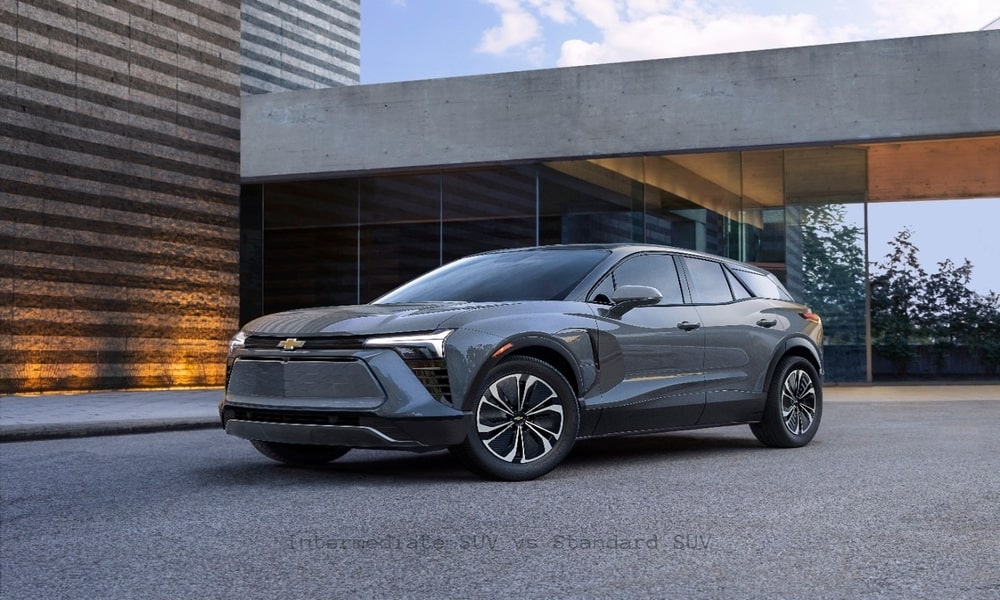Introduction
However, confusion often arises between intermediate SUV vs standard SUV. It’s no wonder that SUVs now dominate the highways. In order to cater for different lifestyles, they combine comfort, functionality, and style. Intermediate SUVs and Standard SUVs cause a lot of confusion among the various types. What’s the Difference? Which one is best? This article compares these options in detail to help you make a decision.
What is an Intermediate SUV?
Intermediate SUVs are the vehicles in mid-size that offer the perfect balance between the compactness and spaciousness found in a car. It has small size than a typical SUV and has extra features. These include popular models, such as the Toyota RAV4 & Honda CR-V. In addition to their versatility, intermediate SUVs appeal to small families, drivers in urban areas, as well as individuals looking for fuel efficiency and comfort.
How to choose an Intermediate SUV?
The intermediate SUV makes a perfect choice if your daily commute involves city streets. It’s also a smart option if the vehicle you choose is one that’s simple to park. Also, it’s a perfect choice for those looking to save money on fuel and enjoy comfort without compromising their budget.
Key Features of Intermediate SUVs
1. Driving ability
They are ideal for suburban and urban settings. Because they’re easier to control and navigate than larger SUVs, these cars are ideal for narrow streets or tight parking spots. While they are smaller in size, many of them offer an excellent driving experience. Their combination of agility and elevated seating is similar to that of an sport utility vehicle.
2. Safety
In terms of safety, intermediate SUVs are geared towards providing the best possible experience. This is why they come with features that enhance driver confidence, including airbags, ABS, traction and lane assist. The majority of intermediate SUVs are also equipped with safety features such as adaptive cruise controls and pedestrian detectors, enhancing driver confidence.
3. Size
These vehicles sit in the sweet spot of being both compact and big. These cars aren’t as big inside as standard SUVs. But they have room enough for five passengers, and they also offer plenty of space in the trunk. It makes them perfect for both weekend and daily adventures.
4. Cost
When comparing intermediate SUV vs standard SUV, cost is a significant factor. Intermediate SUVs can be cheaper than regular SUVs in the initial cost and subsequent costs, like insurance and upkeep. It’s an incredible option for budget-conscious clients who want the SUV benefits but don’t have to break the bank.
5. Fuel average
In terms of fuel efficiency, intermediate SUVs are a great choice. Fuel costs can be reduced by many models that deliver up to 25-30 mpg (miles per gallon). Many even have hybrid options, further improving their eco-friendliness.
What is a Standard SUV?
Standard SUVs tend to be bigger, extra powerful and have a greater diversity of system. These motors have been designed to be versatile, with a vast amount of shipment room, high-tech capabilities, and the capacity to address rugged terrain.
Toyota Highlander, Jeep Grand Cherokee, and Ford Explorer, for instance, are all examples. These SUVs make a tremendous desire for street journeys, households or the ones needing a automobile with enough area to hold a couple of passengers.
What to look for when choosing a Standard SUV?
The best SUV for you is a standard model if, on a regular basis, you are traveling with many people or towing heavy loads. This SUV has a robust construction and spacious interiors that caters to the needs of demanding people.
Key features of Standard SUVs
1. Drivability
While SUVs of the standard size are heavier and bigger, they have been designed with comfort in mind. They are perfect for highway driving. These vehicles are versatile thanks to their high-quality suspension systems and increased ground clearance.
2. Safety
All SUVs feature advanced safety equipment that goes beyond the basics. Many models are equipped with adaptive headlights, 360-degree video cameras, blindspot and rear traffic monitoring. Together with their durable construction, these features provide enhanced protection for every passenger.
3. Size
It is the size that makes SUVs stand out. Most models can fit up to 8 or 7 passengers with their three-row seating. Cargo space is ample, making these models ideal for camping, large loads, or families.
4. Cost
The price of these SUVs is high, despite the many benefits. Standard SUVs generally cost more to own, insure and maintain. The cost is justified for customers who will use the vehicle’s capabilities.
5. Fuel average
Because of their weight, SUVs tend to be less fuel efficient. Some models offer hybrids to enhance efficiency. Buyers that prioritize fuel efficiency should consider carefully this aspect.
Factors to consider before choosing
When deciding between intermediate SUV vs standard SUV, consider these factors:
- Your budget: Calculate what you are able to afford including the price of your car, insurance fees, and fuel.
- Use: Is your primary purpose to drive around in city traffic, on family vacations, or off-road?
- Climate: Urban environments are suitable for intermediate SUVs. Rugged or rural regions suit standard SUVs.
- Passenger needs: How many people regularly travel in the vehicle. For families with more children, SUVs that are standard size will be better.
- Cargo Space: Determine the amount of space required, particularly for bulky or heavy items consisting of sports tools and baggage.
Choosing the right SUV for your Needs
To pick the proper SUV, it’s miles crucial to recognize your options and fit them with capabilities to be had. The intermediate SUV would be a good choice if cost effectiveness, handling ease, and space are important to you. But if power, space and versatility are important to you, an SUV with standard features is the best option.
You should always test-drive different models to better understand performance and comfort. When making an informed purchase, look into the additional features of the vehicle, its warranty coverage and long-term durability.
Conclusion | Intermediate SUV vs Standard SUV
Knowing your priorities will help you decide between an Intermediate SUV and Standard SUV. These SUVs have a good balance of fuel-efficiency, handling and affordability. Standard SUVs cater to adventurers and families with their power, advanced features and ample space. Using this guide you can make an informed decision that fits your budget and lifestyle.




